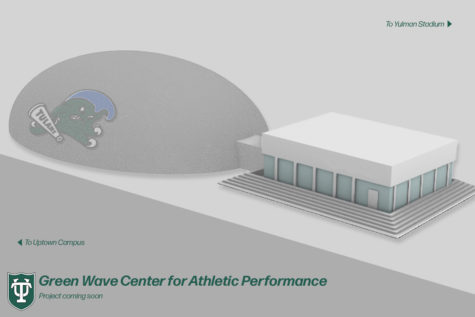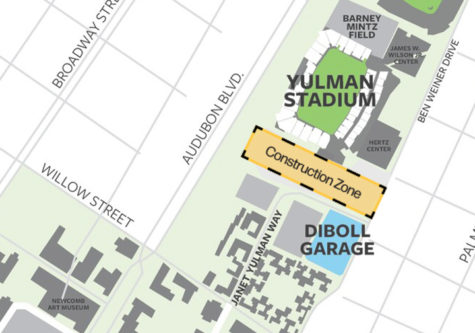FULLABALOO | Tulane to construct new football operations facility
This article is entirely satire. All information and interviews below are fictional and for entertainment purposes only.

In just a few seasons, Tulane Green Wave football players will no longer need to board a bus and bum the New Orleans Saints’ facilities when faced with a disastrous drizzle. After decades of traversing from Uptown to either the Caesars Superdome in New Orleans’ Central Business District or to the Ochsner Sports Performance Center in Jefferson Parish, Tulane Athletics has announced plans to construct a state-of-the-art facility of their own that will include an absolutely necessary indoor practice facility.
For the first time since “The Bubble” stood in Bruff Quad in the 2000s, Tulane’s campus will once again feature a bubble — this time to host dry football practices instead of hosting a bookstore and dining services. And what better location to construct such a project than the site of another state-of-the-art structure: the Reily Student Recreation Center.
As Tulane continues to maintain its lead in the rankings for Happiest Students, the Reily Recreation Center stands as a clear misstep in the university’s investment into students’ happiness. A glaring reminder of administration’s failure to please its student body, sporting abominations like two (?) swimming pools, indoor basketball facilities, and a top-of-the-line weight room. Frequented by students and faculty alike, Reily provides egregious fitness facilities, as well as hosts a wide range of student and professionally taught classes at an inconvenient discounted price.
Some students are not happy with the university’s decision to eliminate Reily, especially given the fact that Reily’s construction was funded by an increase in student activity fees. “How am I ever going to get as jacked as those guys now,” said Tulane student Jacques McJockington in response to the university’s decision to replace Reily with a football facility. “This is an attack on my culture,” McJockington reiterated.
The university has not yet announced plans for a facility to replace Reily, but in addition to the indoor football field, Tulane football will also boast one of the nation’s top football operation centers. The 69,000-square-foot facility will include a new weight room exclusively for the football team, along with a locker room featuring individual beds for each player, team meeting rooms and a players lounge that will feature a functioning pool and golf simulator among other amenities.

The university has not disclosed the total cost of the new facility, but sources are calling it, “pocket change,” stating the rumored $42.069 million price tag to be, “nothing for students to worry over.” The university plans to pay for the facility by selling naming rights to the highest bidder. According to some reports, one of the same families who already has multiple buildings on campus named after them will also buy these rights.
This is the culmination of university president Mike Feetz’s goal to differentiate himself from former presidents Rufus Harris and Herbert Longenecker who de-emphasized Tulane football in 1951 and led the Wave out of the SEC in 1966 respectively.
“I respect former President Dinwiddie’s ambition to bolster the Wave’s performance on the gridiron nearly 100 years ago by building Tulane Stadium III, and I believe investments could lead to more capital in the future,” said Feetz. “Tulane is the hottest school in the country, and we realized we can compete nationally if we all buy in — it will be a football facility unlike any other.”
“I wouldn’t be surprised if the Saints came back here to practice like in the ’60s when we had some of the sickest facilities in America,” Wave head coach Billie Gritz said. “If other private institutions such as USC — who we just beat in the Cotton Bowl — can do it, what can stop the mighty Wave?”
Despite the frequent rainy days, Gritz highlighted the significance of Tulane’s location in New Orleans — one of the biggest recruiting hotbeds in America. Though in-state rival LSU averages a staggering one inch of rain more than New Orleans annually, the Tigers have won three national championships since opening their indoor practice field in the 1990s.
Your donation will support the student journalists of Tulane University. Your contribution will allow us to purchase equipment and cover our annual website hosting costs.




Leave a Comment